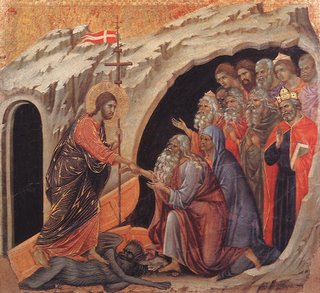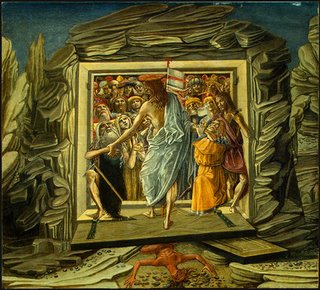 The icon ... represents as it were the mysterious inner dimension of the event of Easter which is indicated by a few words of Scripture and which we profess in the Creed when we say, "He descended into hell". In the perspective of the icon, this is an affirmation concerning Jesus' victory. The icon shows him having shattered the bolt of this world, having torn its gates from their hinges. It depicts him as the "stronger man" who has opened and penetrated the domain of the "strong man". It portrays him as the Victor, having burst through the supposedly impregnable fortress of death, such that death is now no longer a place of no return; its doors lie open. Christ, in the aura of his wounded love, stands in this doorway, addresses the still somnolent Adam and takes him by the hand to lead him forth. The liturgy of Holy Saturday circles around this event.
The icon ... represents as it were the mysterious inner dimension of the event of Easter which is indicated by a few words of Scripture and which we profess in the Creed when we say, "He descended into hell". In the perspective of the icon, this is an affirmation concerning Jesus' victory. The icon shows him having shattered the bolt of this world, having torn its gates from their hinges. It depicts him as the "stronger man" who has opened and penetrated the domain of the "strong man". It portrays him as the Victor, having burst through the supposedly impregnable fortress of death, such that death is now no longer a place of no return; its doors lie open. Christ, in the aura of his wounded love, stands in this doorway, addresses the still somnolent Adam and takes him by the hand to lead him forth. The liturgy of Holy Saturday circles around this event.He brings consolation to this place of desolation, he brings warmth to this place of infernal cold.

Christ's suffering, the greatest one could conceive, was like that of the damned who cannot be damned any more. That is, his suffering went to the length of infernal punishment ... He alone through such a death entered into glory. He wanted to experience the poena sensus like the damned in Hell for the glorifying of his Father, and so as to show that one should obey the Father even to the utmost torture. That means: praising and glorifying God in every possible way for our justification--which is what Christ has done.
No comments:
Post a Comment